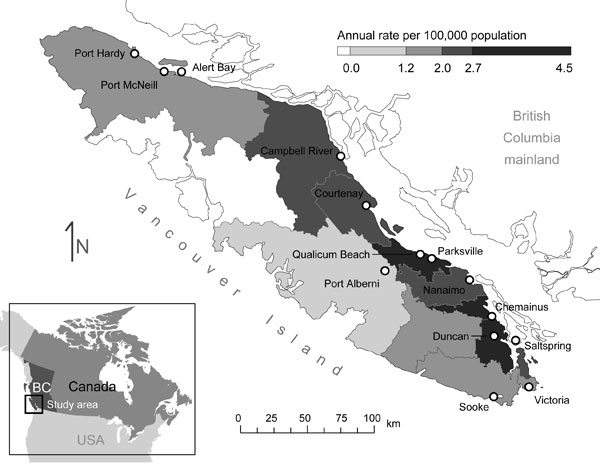Volume 14, Number 11—November 2008
Dispatch
Tourism and Specific Risk Areas for Cryptococcus gattii, Vancouver Island, Canada
Figure

Figure. Annual rate of infection with Cryptococcus gattii by local administrative area, 1999–2006 (9), and distribution of visitor center cities on Vancouver Island, British Columbia (BC), Canada. Only visitor centers that were included in the analysis are shown.
References
- Casadevall A, Perfect JR. Cryptococcus neoformans: molecular pathogenesis and clinical management. Washington: American Society for Microbiology Press; 1998.
- Stephen C, Lester S, Black W, Fyfe M, Raverty S. Multispecies outbreak of cryptococcosis on southern Vancouver Island, British Columbia. Can Vet J. 2002;43:792–4.PubMedGoogle Scholar
- Kidd SE, Chow Y, Mak S, Bach PJ, Chen H, Hingston AO, Characterization of environmental sources of the human and animal pathogen Cryptococcus gattii in British Columbia, Canada, and the Pacific Northwest of the United States. Appl Environ Microbiol. 2007;73:1433–43. DOIPubMedGoogle Scholar
- Kidd SE, Hagen F, Tscharke RL, Huynh M, Bartlett KH, Fyfe M, A rare genotype of Cryptococcus gattii caused the cryptococcosis outbreak on Vancouver Island (British Columbia, Canada). Proc Natl Acad Sci U S A. 2004;101:17258–63. DOIPubMedGoogle Scholar
- MacDougall L, Kidd SE, Galanis E, Mak S, Leslie MJ, Cieslak PR, Spread of Cryptococcus gattii in British Columbia, Canada, and detection in the Pacific Northwest, USA. Emerg Infect Dis. 2007;13:42–50.PubMedGoogle Scholar
- Duncan C, Stephen C, Lester S, Bartlett KH. Sub-clinical infection and asymptomatic carriage of Cryptococcus gattii in dogs and cats during an outbreak of cryptococcosis. Med Mycol. 2005;43:511–6. DOIPubMedGoogle Scholar
- Lindberg J, Hagen F, Laursen A, Stenderup J, Boekhout T. Cryptococcus gattii risk for tourists visiting Vancouver Island, Canada. Emerg Infect Dis. 2007;13:178–9.PubMedGoogle Scholar
- MacDougall L, Fyfe M. Emergence of Cryptococcus gattii in a novel environment provides clues to its incubation period. J Clin Microbiol. 2006;44:1851–2. DOIPubMedGoogle Scholar
- BC Centre for Disease Control. Cryptococcus gattii surveillance summary, British Columbia, 1999–2006. Vancouver (Canada): BC Centre for Disease Control; 2007 [cited 2008 Aug 14]. Available from http://www.bccdc.org/topic.php?item=109
- Tourism BC. Regional Profile: Vancouver Island, Victoria, and the Gulf Islands. Victoria (Canada): Tourism BC Research Services; 2007 [cited 2008 Aug 14]. Available from http://www.tourismbc.com/special_reports.asp?id=2065
- Askling HH, Nilsson J, Tegnell A, Janzon R, Ekdahl K. Malaria risk in travelers. Emerg Infect Dis. 2005;11:436–41.PubMedGoogle Scholar
- Ekdahl K, Andersson Y. Regional risks and seasonality in travel-associated campylobacteriosis. BMC Infect Dis. 2004;4:54. DOIPubMedGoogle Scholar
- Ekdahl K, de Jong B, Wollin R, Andersson Y. Travel-associated non-typhoidal salmonellosis: geographical and seasonal differences and serotype distribution. Clin Microbiol Infect. 2005;11:138–44. DOIPubMedGoogle Scholar
- Ekdahl K, Andersson Y. The epidemiology of travel-associated shigellosis—regional risks, seasonality and serogroups. J Infect. 2005;51:222–9. DOIPubMedGoogle Scholar
Page created: July 18, 2010
Page updated: July 18, 2010
Page reviewed: July 18, 2010
The conclusions, findings, and opinions expressed by authors contributing to this journal do not necessarily reflect the official position of the U.S. Department of Health and Human Services, the Public Health Service, the Centers for Disease Control and Prevention, or the authors' affiliated institutions. Use of trade names is for identification only and does not imply endorsement by any of the groups named above.